T3 2019 HI6027 Business and Corporate Law Case Study Analysis
VerifiedAdded on 2022/08/23
|14
|1618
|16
Case Study
AI Summary
This case study analyzes two scenarios related to business and corporate law. The first case examines a fraud case where an imposter obtained funds from a museum, exploring issues of fraudulent misrepresentation under common law and statutory law. The analysis applies the elements of fraud, referencing key legal principles and cases like *Nadinic vs. Drinkwater* and *Forrest vs. ASIC*, concluding the museum would likely succeed in recovering the money. The second case involves pre-registration contracts and the liabilities of individuals acting on behalf of a company before its formal registration. The analysis applies sections 131, 132, and 133 of the Corporations Act, along with the case *Commonwealth Bank of Australia vs. Australian Solar Information Pty Ltd.*, to determine the liabilities of the parties involved and the impact of company registration on existing contracts. The conclusion clarifies the potential release of liability for Kellie and the implications of registering the company.
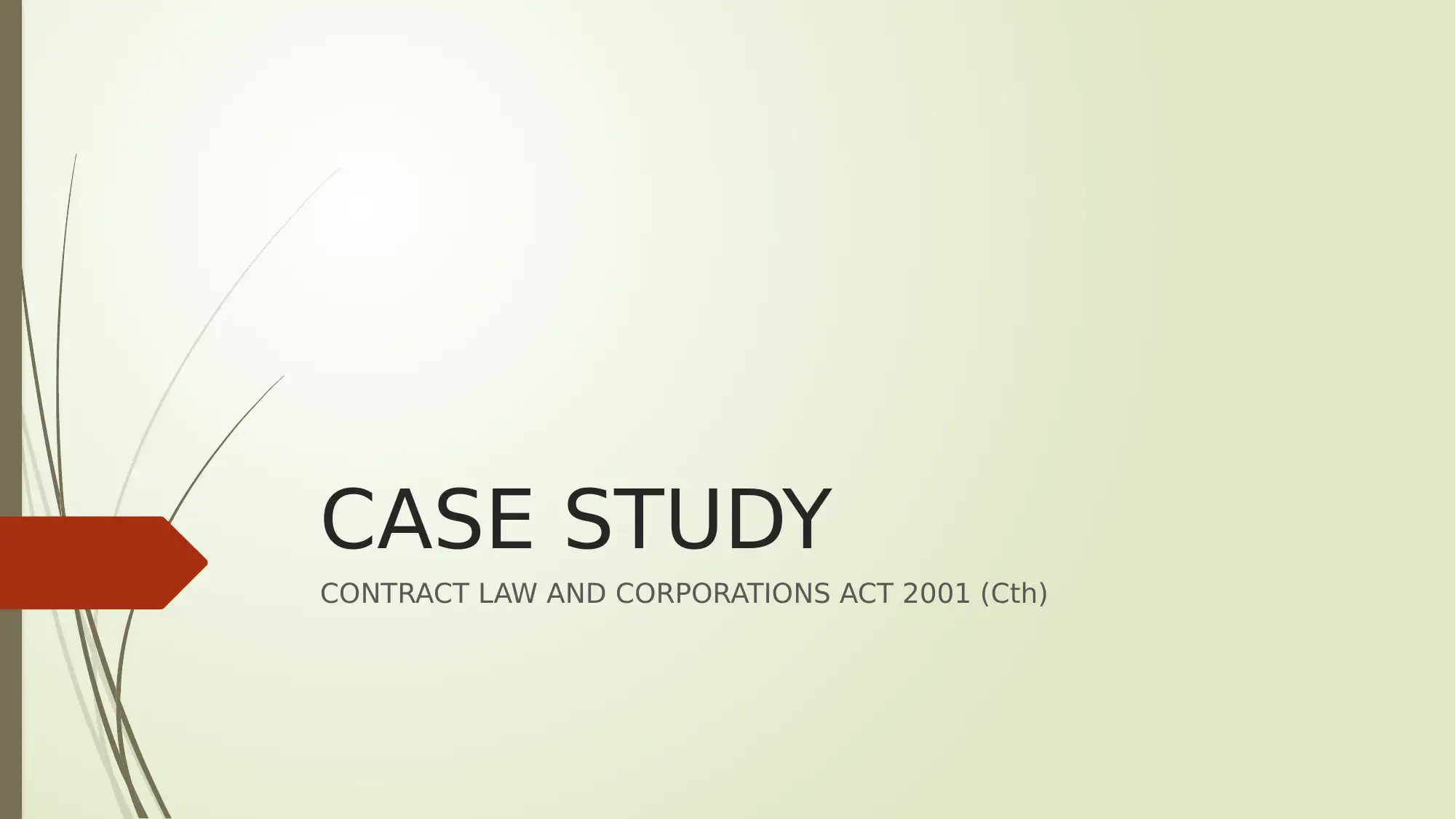
CASE STUDY
CONTRACT LAW AND CORPORATIONS ACT 2001 (Cth)
CONTRACT LAW AND CORPORATIONS ACT 2001 (Cth)
Paraphrase This Document
Need a fresh take? Get an instant paraphrase of this document with our AI Paraphraser
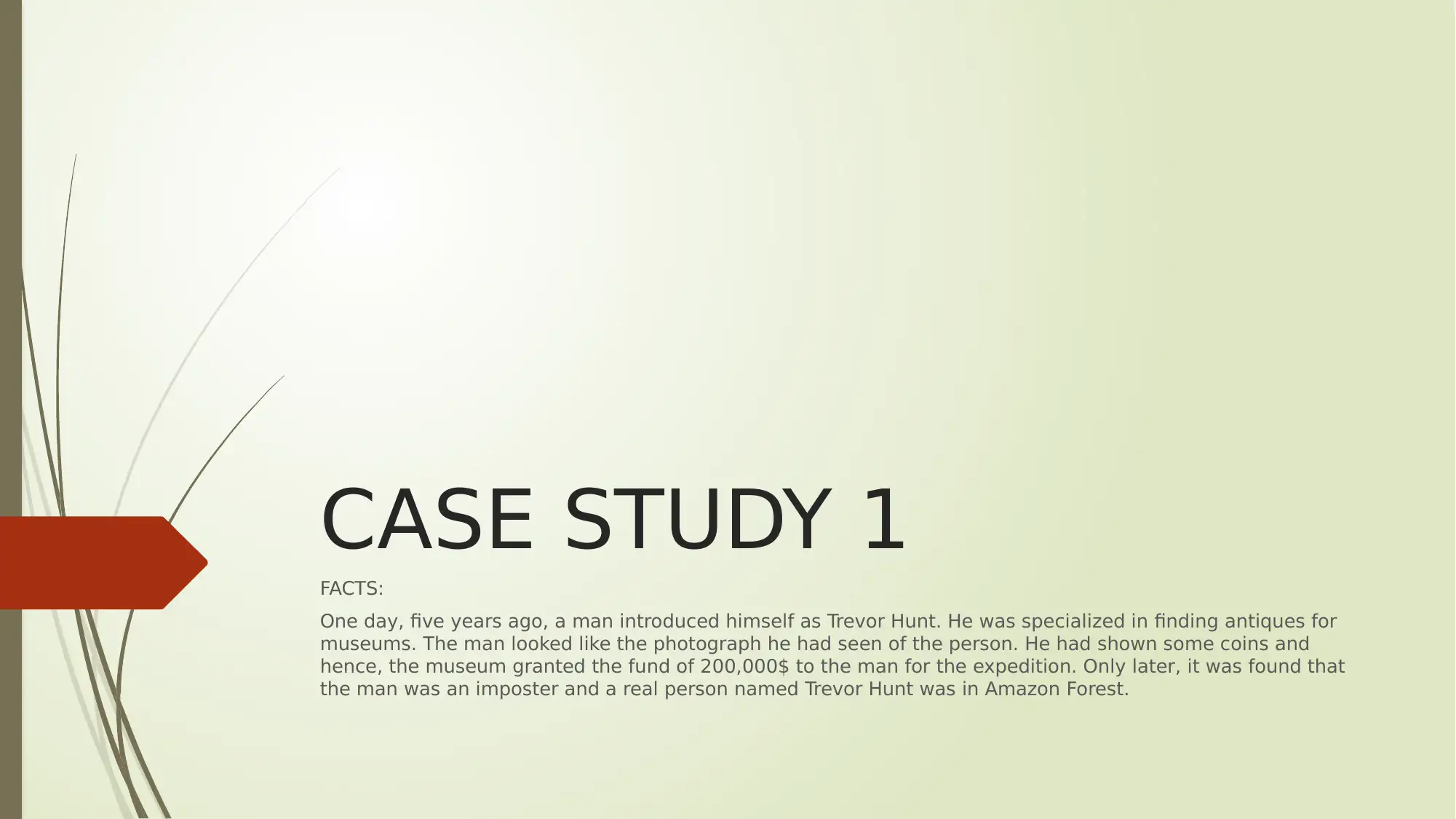
CASE STUDY 1
FACTS:
One day, five years ago, a man introduced himself as Trevor Hunt. He was specialized in finding antiques for
museums. The man looked like the photograph he had seen of the person. He had shown some coins and
hence, the museum granted the fund of 200,000$ to the man for the expedition. Only later, it was found that
the man was an imposter and a real person named Trevor Hunt was in Amazon Forest.
FACTS:
One day, five years ago, a man introduced himself as Trevor Hunt. He was specialized in finding antiques for
museums. The man looked like the photograph he had seen of the person. He had shown some coins and
hence, the museum granted the fund of 200,000$ to the man for the expedition. Only later, it was found that
the man was an imposter and a real person named Trevor Hunt was in Amazon Forest.
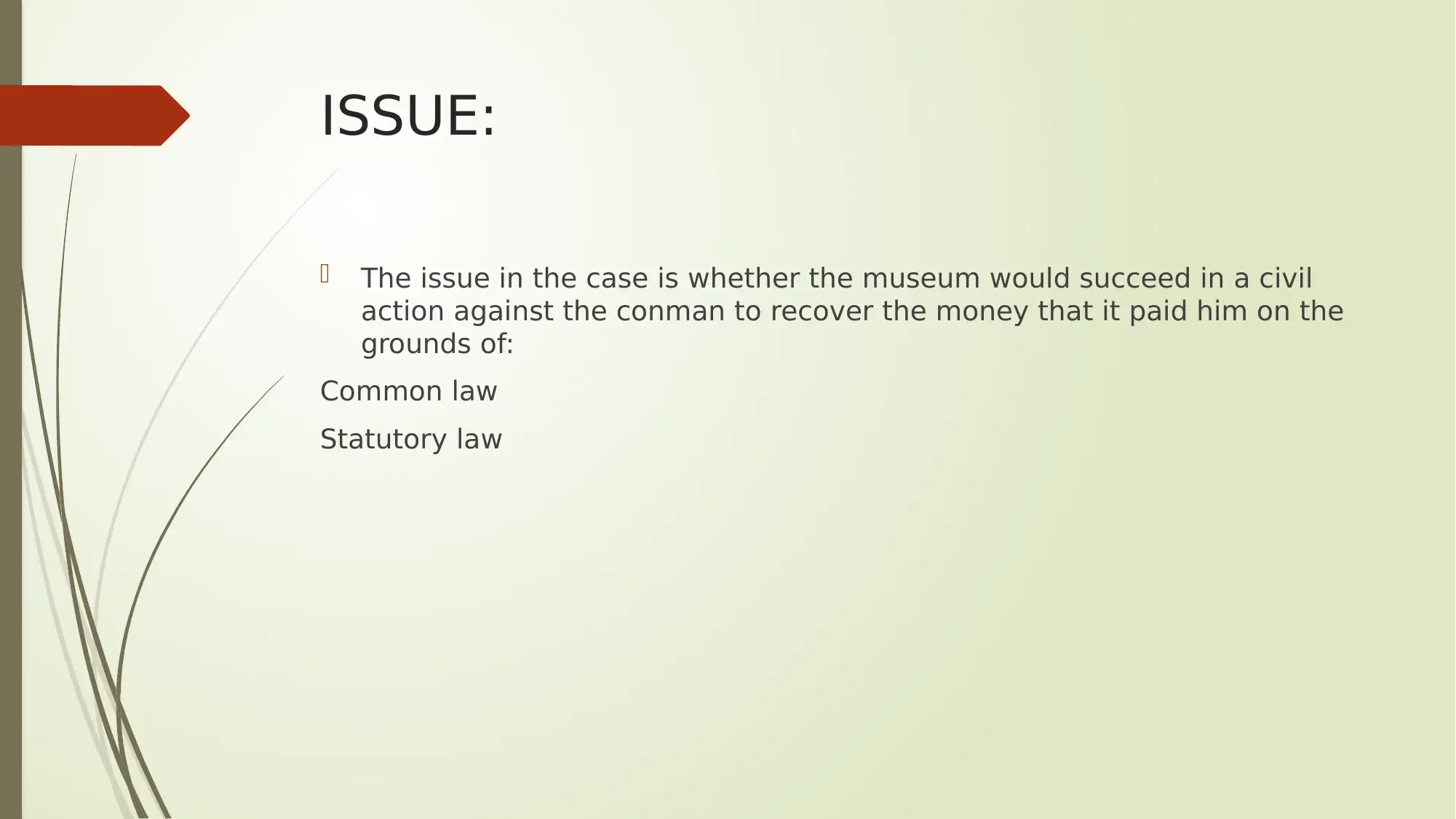
ISSUE:
The issue in the case is whether the museum would succeed in a civil
action against the conman to recover the money that it paid him on the
grounds of:
Common law
Statutory law
The issue in the case is whether the museum would succeed in a civil
action against the conman to recover the money that it paid him on the
grounds of:
Common law
Statutory law
⊘ This is a preview!⊘
Do you want full access?
Subscribe today to unlock all pages.

Trusted by 1+ million students worldwide
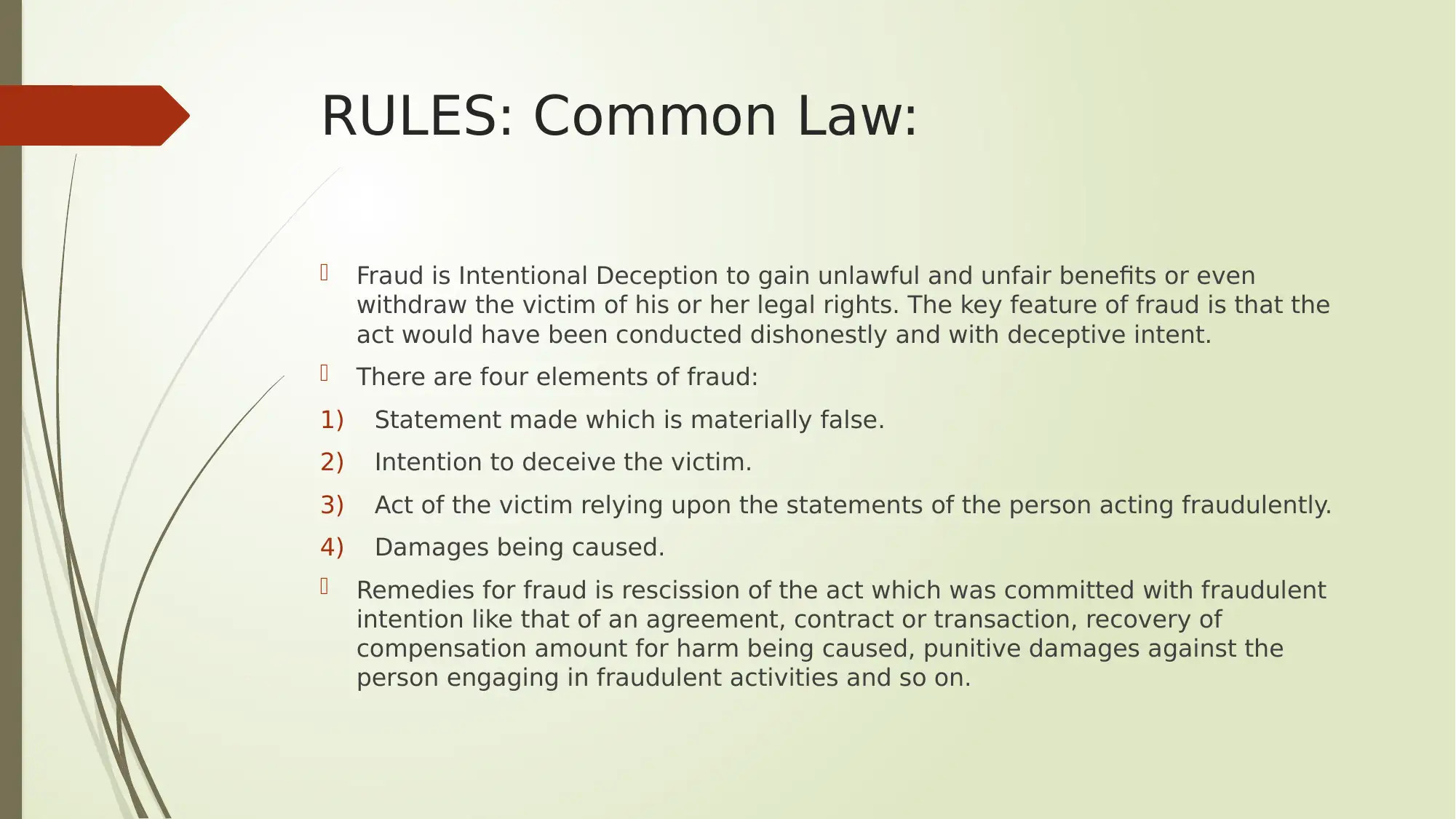
RULES: Common Law:
Fraud is Intentional Deception to gain unlawful and unfair benefits or even
withdraw the victim of his or her legal rights. The key feature of fraud is that the
act would have been conducted dishonestly and with deceptive intent.
There are four elements of fraud:
1) Statement made which is materially false.
2) Intention to deceive the victim.
3) Act of the victim relying upon the statements of the person acting fraudulently.
4) Damages being caused.
Remedies for fraud is rescission of the act which was committed with fraudulent
intention like that of an agreement, contract or transaction, recovery of
compensation amount for harm being caused, punitive damages against the
person engaging in fraudulent activities and so on.
Fraud is Intentional Deception to gain unlawful and unfair benefits or even
withdraw the victim of his or her legal rights. The key feature of fraud is that the
act would have been conducted dishonestly and with deceptive intent.
There are four elements of fraud:
1) Statement made which is materially false.
2) Intention to deceive the victim.
3) Act of the victim relying upon the statements of the person acting fraudulently.
4) Damages being caused.
Remedies for fraud is rescission of the act which was committed with fraudulent
intention like that of an agreement, contract or transaction, recovery of
compensation amount for harm being caused, punitive damages against the
person engaging in fraudulent activities and so on.
Paraphrase This Document
Need a fresh take? Get an instant paraphrase of this document with our AI Paraphraser
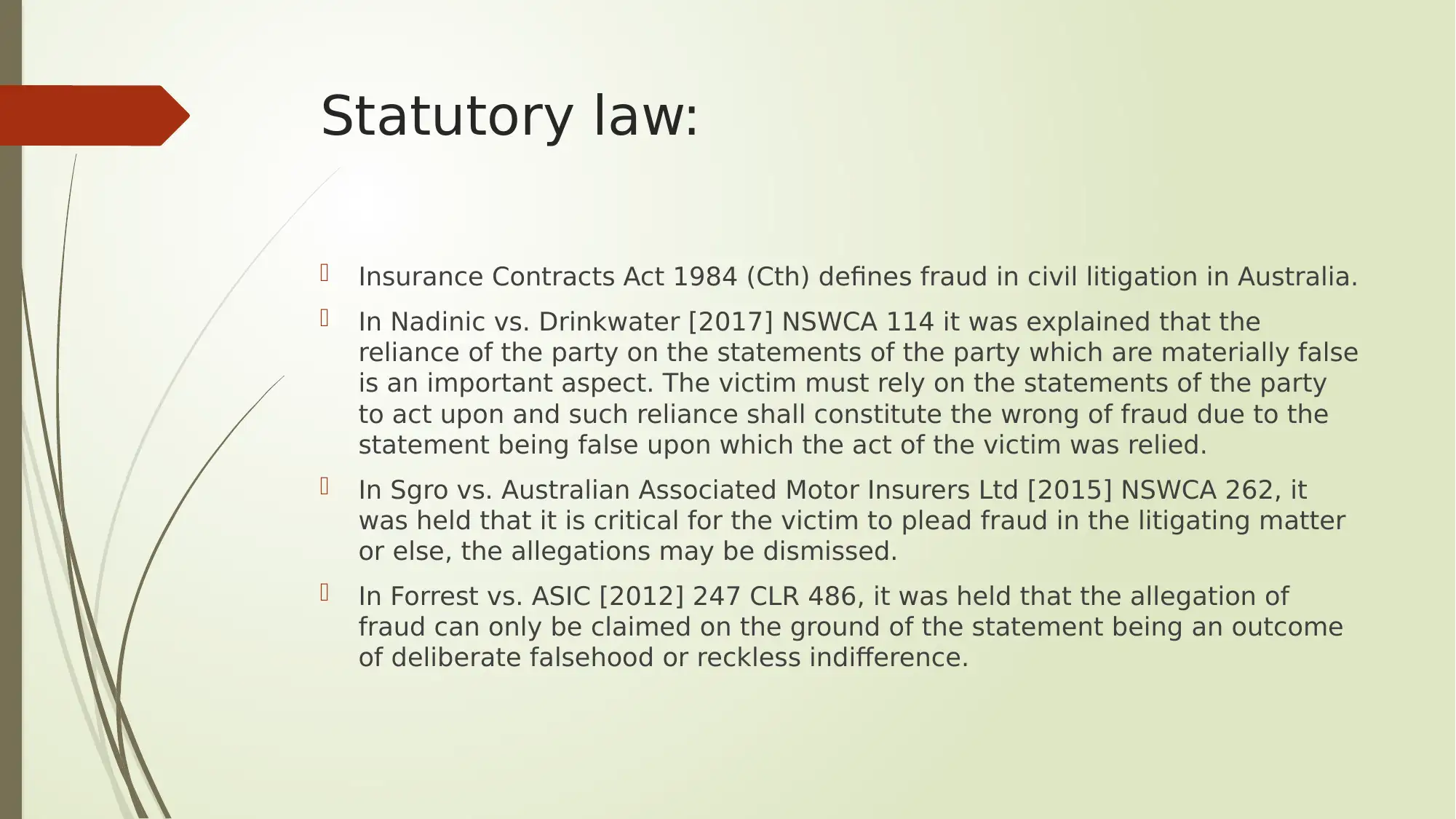
Statutory law:
Insurance Contracts Act 1984 (Cth) defines fraud in civil litigation in Australia.
In Nadinic vs. Drinkwater [2017] NSWCA 114 it was explained that the
reliance of the party on the statements of the party which are materially false
is an important aspect. The victim must rely on the statements of the party
to act upon and such reliance shall constitute the wrong of fraud due to the
statement being false upon which the act of the victim was relied.
In Sgro vs. Australian Associated Motor Insurers Ltd [2015] NSWCA 262, it
was held that it is critical for the victim to plead fraud in the litigating matter
or else, the allegations may be dismissed.
In Forrest vs. ASIC [2012] 247 CLR 486, it was held that the allegation of
fraud can only be claimed on the ground of the statement being an outcome
of deliberate falsehood or reckless indifference.
Insurance Contracts Act 1984 (Cth) defines fraud in civil litigation in Australia.
In Nadinic vs. Drinkwater [2017] NSWCA 114 it was explained that the
reliance of the party on the statements of the party which are materially false
is an important aspect. The victim must rely on the statements of the party
to act upon and such reliance shall constitute the wrong of fraud due to the
statement being false upon which the act of the victim was relied.
In Sgro vs. Australian Associated Motor Insurers Ltd [2015] NSWCA 262, it
was held that it is critical for the victim to plead fraud in the litigating matter
or else, the allegations may be dismissed.
In Forrest vs. ASIC [2012] 247 CLR 486, it was held that the allegation of
fraud can only be claimed on the ground of the statement being an outcome
of deliberate falsehood or reckless indifference.
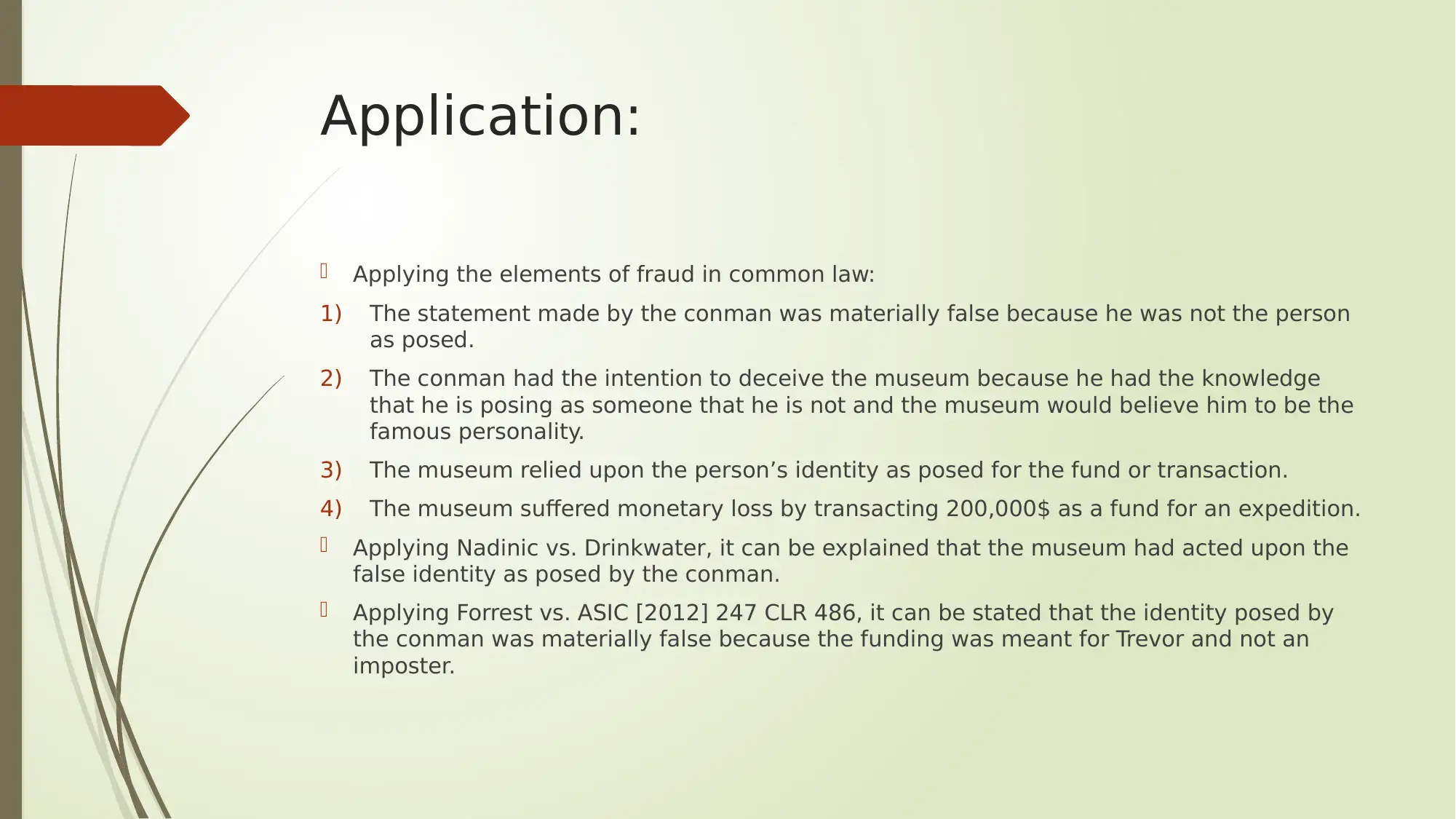
Application:
Applying the elements of fraud in common law:
1) The statement made by the conman was materially false because he was not the person
as posed.
2) The conman had the intention to deceive the museum because he had the knowledge
that he is posing as someone that he is not and the museum would believe him to be the
famous personality.
3) The museum relied upon the person’s identity as posed for the fund or transaction.
4) The museum suffered monetary loss by transacting 200,000$ as a fund for an expedition.
Applying Nadinic vs. Drinkwater, it can be explained that the museum had acted upon the
false identity as posed by the conman.
Applying Forrest vs. ASIC [2012] 247 CLR 486, it can be stated that the identity posed by
the conman was materially false because the funding was meant for Trevor and not an
imposter.
Applying the elements of fraud in common law:
1) The statement made by the conman was materially false because he was not the person
as posed.
2) The conman had the intention to deceive the museum because he had the knowledge
that he is posing as someone that he is not and the museum would believe him to be the
famous personality.
3) The museum relied upon the person’s identity as posed for the fund or transaction.
4) The museum suffered monetary loss by transacting 200,000$ as a fund for an expedition.
Applying Nadinic vs. Drinkwater, it can be explained that the museum had acted upon the
false identity as posed by the conman.
Applying Forrest vs. ASIC [2012] 247 CLR 486, it can be stated that the identity posed by
the conman was materially false because the funding was meant for Trevor and not an
imposter.
⊘ This is a preview!⊘
Do you want full access?
Subscribe today to unlock all pages.

Trusted by 1+ million students worldwide
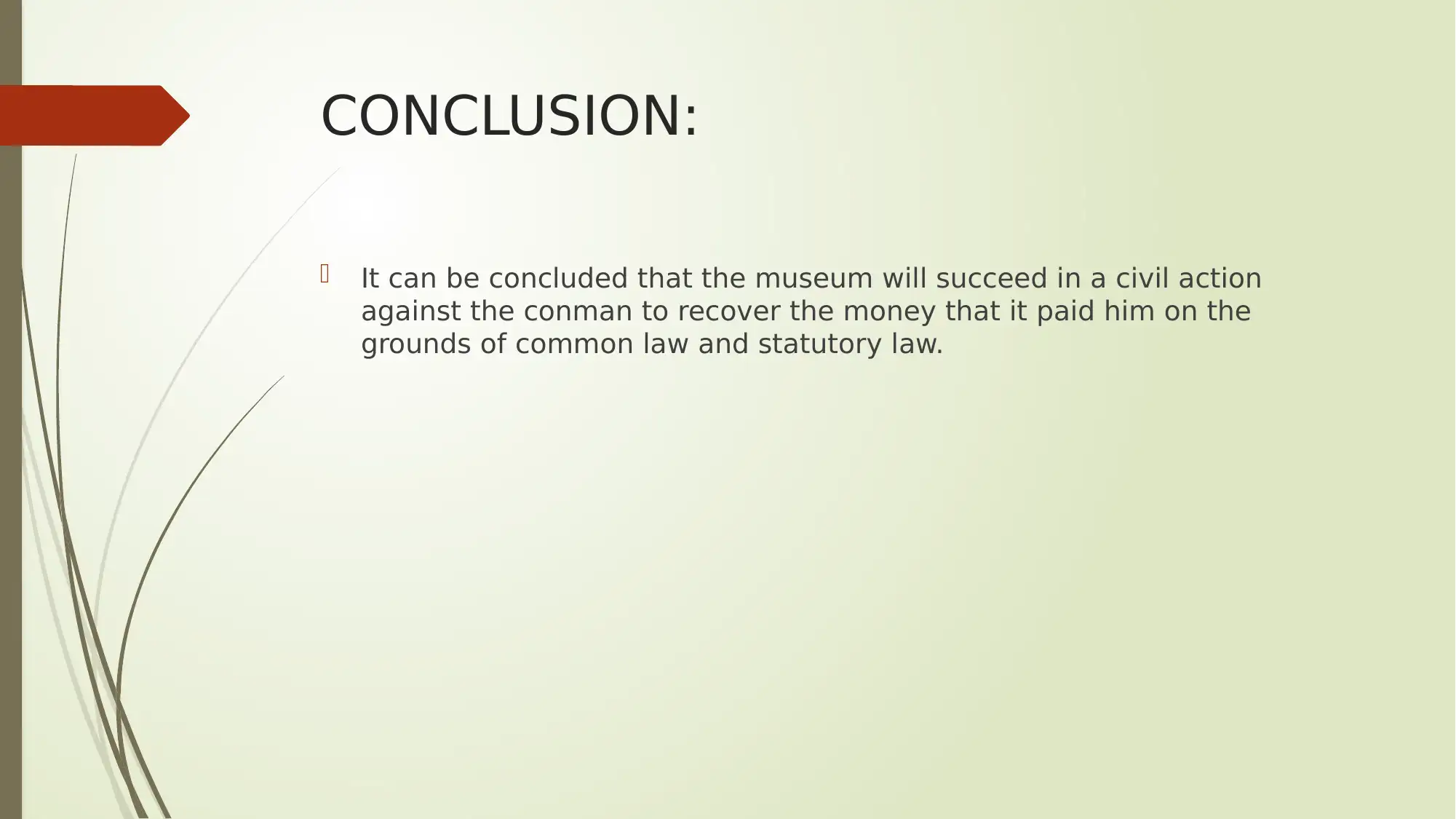
CONCLUSION:
It can be concluded that the museum will succeed in a civil action
against the conman to recover the money that it paid him on the
grounds of common law and statutory law.
It can be concluded that the museum will succeed in a civil action
against the conman to recover the money that it paid him on the
grounds of common law and statutory law.
Paraphrase This Document
Need a fresh take? Get an instant paraphrase of this document with our AI Paraphraser
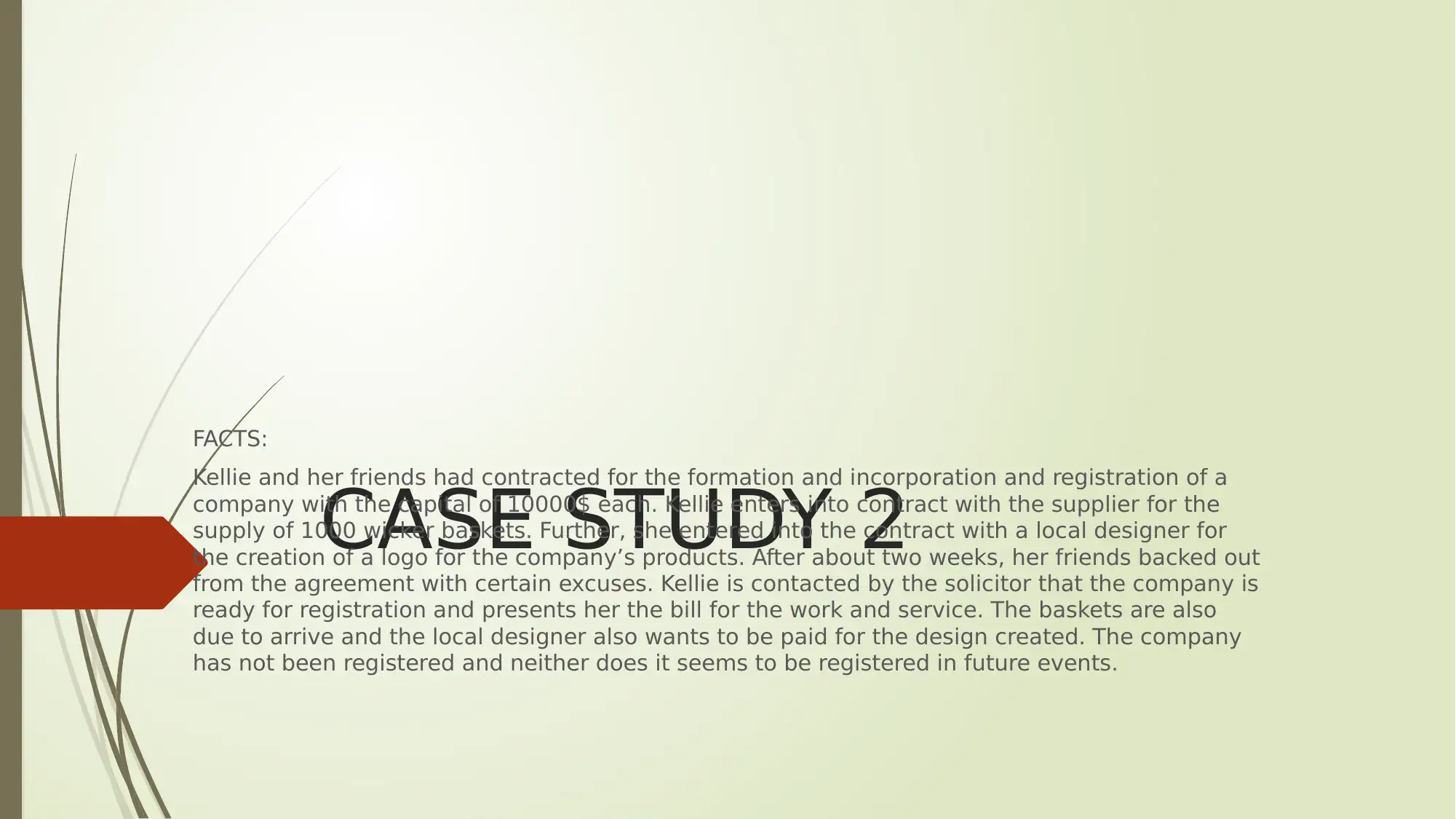
CASE STUDY 2
FACTS:
Kellie and her friends had contracted for the formation and incorporation and registration of a
company with the capital of 10000$ each. Kellie enters into contract with the supplier for the
supply of 1000 wicker baskets. Further, she entered into the contract with a local designer for
the creation of a logo for the company’s products. After about two weeks, her friends backed out
from the agreement with certain excuses. Kellie is contacted by the solicitor that the company is
ready for registration and presents her the bill for the work and service. The baskets are also
due to arrive and the local designer also wants to be paid for the design created. The company
has not been registered and neither does it seems to be registered in future events.
FACTS:
Kellie and her friends had contracted for the formation and incorporation and registration of a
company with the capital of 10000$ each. Kellie enters into contract with the supplier for the
supply of 1000 wicker baskets. Further, she entered into the contract with a local designer for
the creation of a logo for the company’s products. After about two weeks, her friends backed out
from the agreement with certain excuses. Kellie is contacted by the solicitor that the company is
ready for registration and presents her the bill for the work and service. The baskets are also
due to arrive and the local designer also wants to be paid for the design created. The company
has not been registered and neither does it seems to be registered in future events.
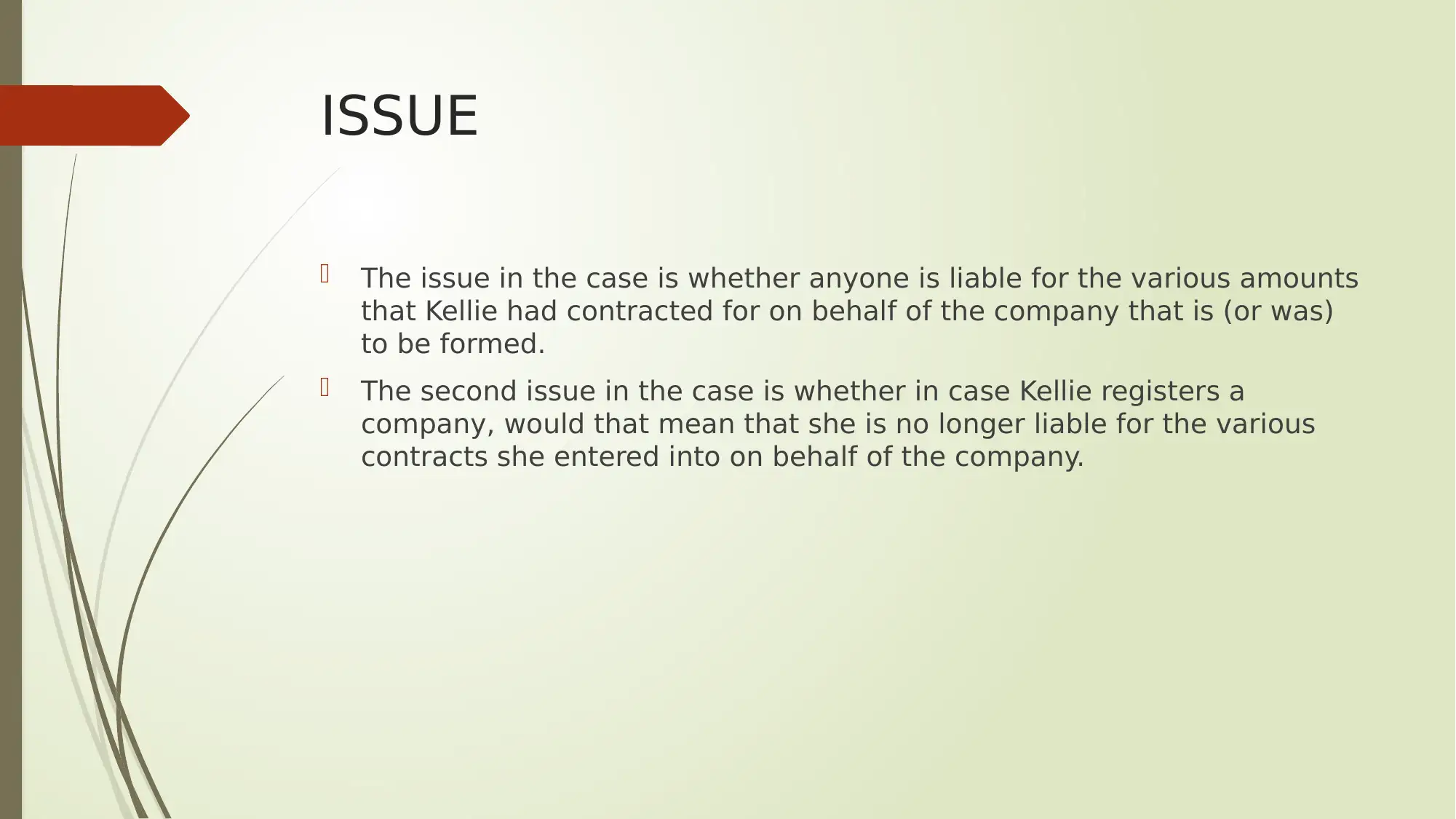
ISSUE
The issue in the case is whether anyone is liable for the various amounts
that Kellie had contracted for on behalf of the company that is (or was)
to be formed.
The second issue in the case is whether in case Kellie registers a
company, would that mean that she is no longer liable for the various
contracts she entered into on behalf of the company.
The issue in the case is whether anyone is liable for the various amounts
that Kellie had contracted for on behalf of the company that is (or was)
to be formed.
The second issue in the case is whether in case Kellie registers a
company, would that mean that she is no longer liable for the various
contracts she entered into on behalf of the company.
⊘ This is a preview!⊘
Do you want full access?
Subscribe today to unlock all pages.

Trusted by 1+ million students worldwide
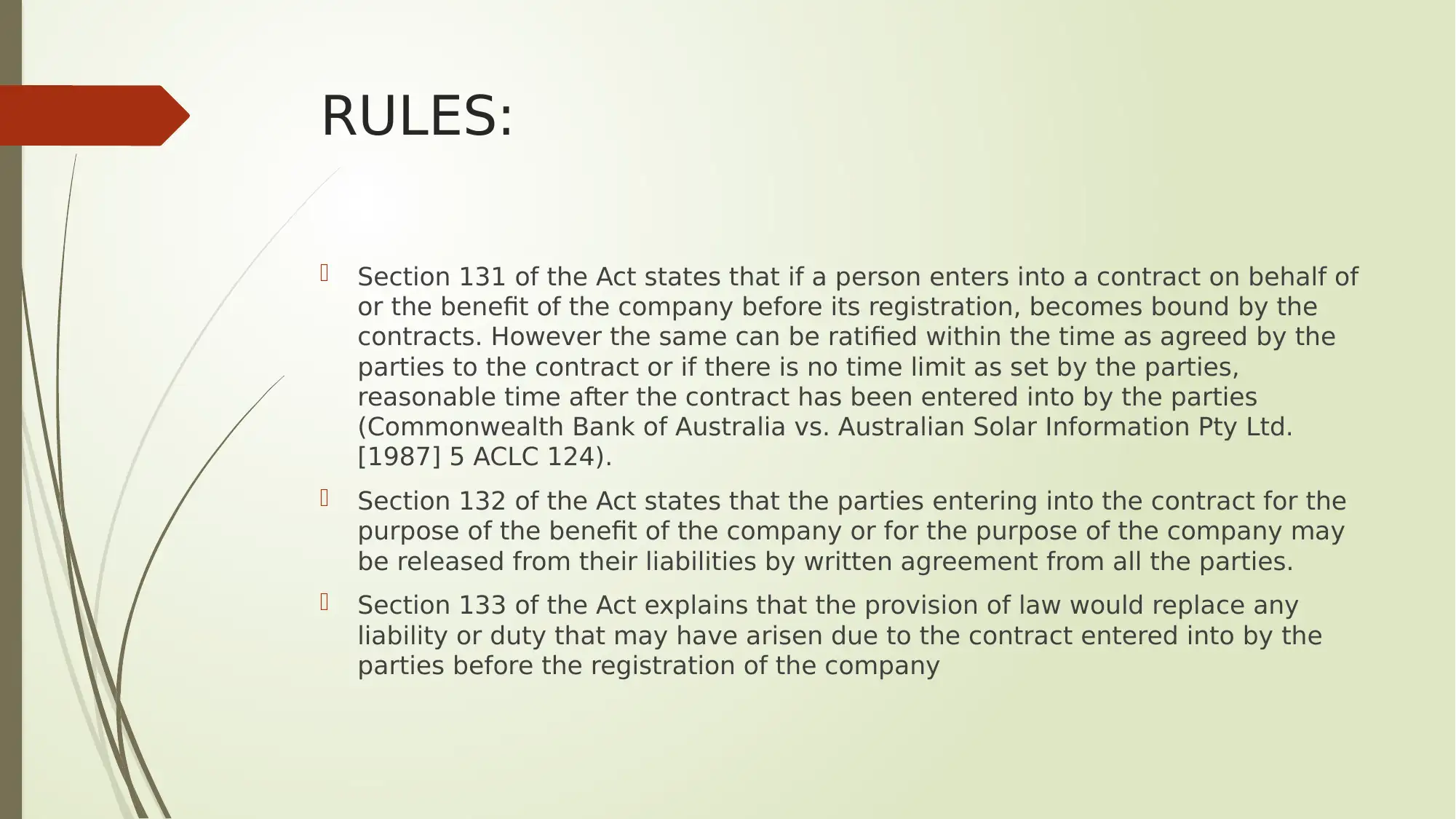
RULES:
Section 131 of the Act states that if a person enters into a contract on behalf of
or the benefit of the company before its registration, becomes bound by the
contracts. However the same can be ratified within the time as agreed by the
parties to the contract or if there is no time limit as set by the parties,
reasonable time after the contract has been entered into by the parties
(Commonwealth Bank of Australia vs. Australian Solar Information Pty Ltd.
[1987] 5 ACLC 124).
Section 132 of the Act states that the parties entering into the contract for the
purpose of the benefit of the company or for the purpose of the company may
be released from their liabilities by written agreement from all the parties.
Section 133 of the Act explains that the provision of law would replace any
liability or duty that may have arisen due to the contract entered into by the
parties before the registration of the company
Section 131 of the Act states that if a person enters into a contract on behalf of
or the benefit of the company before its registration, becomes bound by the
contracts. However the same can be ratified within the time as agreed by the
parties to the contract or if there is no time limit as set by the parties,
reasonable time after the contract has been entered into by the parties
(Commonwealth Bank of Australia vs. Australian Solar Information Pty Ltd.
[1987] 5 ACLC 124).
Section 132 of the Act states that the parties entering into the contract for the
purpose of the benefit of the company or for the purpose of the company may
be released from their liabilities by written agreement from all the parties.
Section 133 of the Act explains that the provision of law would replace any
liability or duty that may have arisen due to the contract entered into by the
parties before the registration of the company
Paraphrase This Document
Need a fresh take? Get an instant paraphrase of this document with our AI Paraphraser
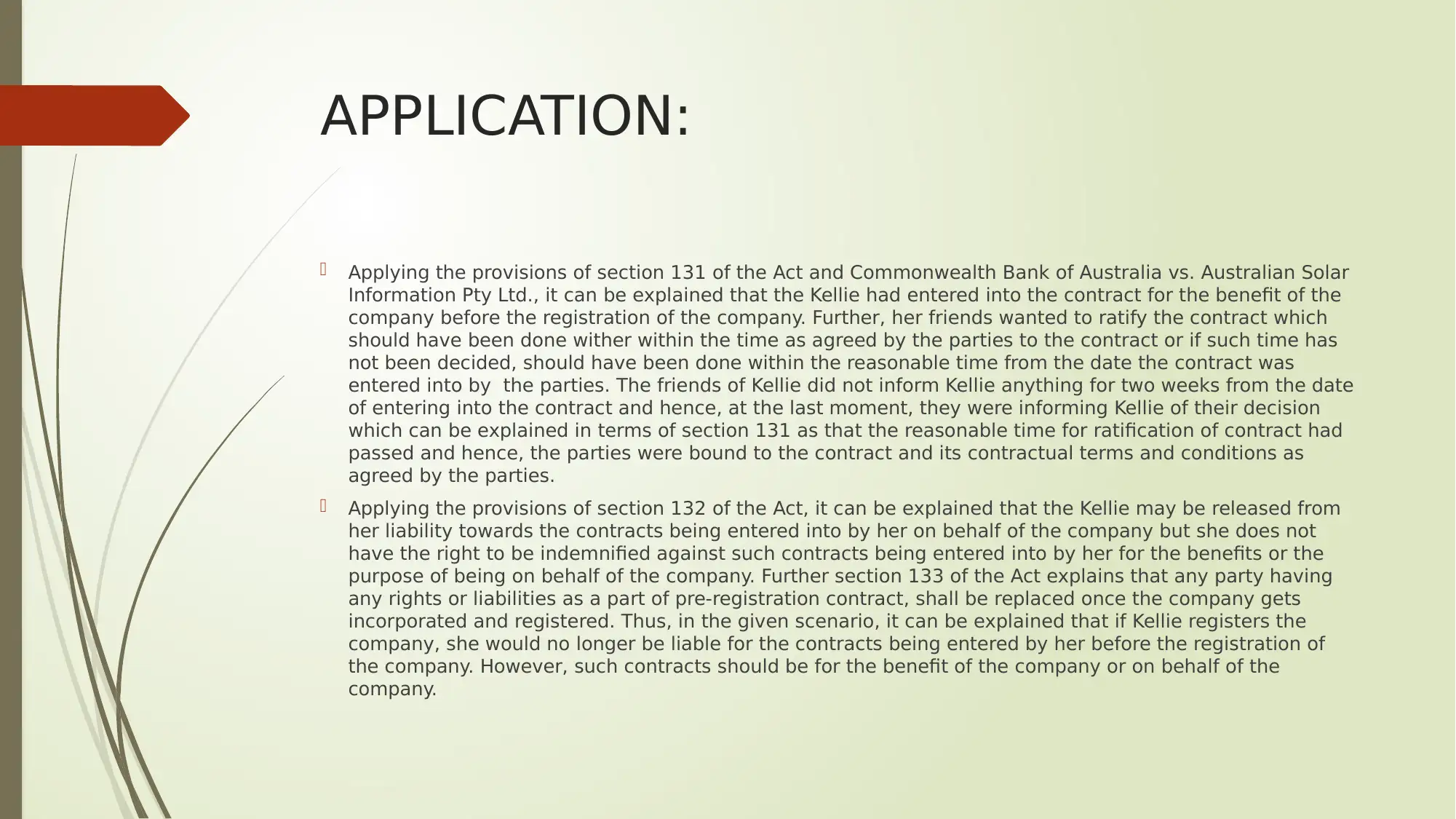
APPLICATION:
Applying the provisions of section 131 of the Act and Commonwealth Bank of Australia vs. Australian Solar
Information Pty Ltd., it can be explained that the Kellie had entered into the contract for the benefit of the
company before the registration of the company. Further, her friends wanted to ratify the contract which
should have been done wither within the time as agreed by the parties to the contract or if such time has
not been decided, should have been done within the reasonable time from the date the contract was
entered into by the parties. The friends of Kellie did not inform Kellie anything for two weeks from the date
of entering into the contract and hence, at the last moment, they were informing Kellie of their decision
which can be explained in terms of section 131 as that the reasonable time for ratification of contract had
passed and hence, the parties were bound to the contract and its contractual terms and conditions as
agreed by the parties.
Applying the provisions of section 132 of the Act, it can be explained that the Kellie may be released from
her liability towards the contracts being entered into by her on behalf of the company but she does not
have the right to be indemnified against such contracts being entered into by her for the benefits or the
purpose of being on behalf of the company. Further section 133 of the Act explains that any party having
any rights or liabilities as a part of pre-registration contract, shall be replaced once the company gets
incorporated and registered. Thus, in the given scenario, it can be explained that if Kellie registers the
company, she would no longer be liable for the contracts being entered by her before the registration of
the company. However, such contracts should be for the benefit of the company or on behalf of the
company.
Applying the provisions of section 131 of the Act and Commonwealth Bank of Australia vs. Australian Solar
Information Pty Ltd., it can be explained that the Kellie had entered into the contract for the benefit of the
company before the registration of the company. Further, her friends wanted to ratify the contract which
should have been done wither within the time as agreed by the parties to the contract or if such time has
not been decided, should have been done within the reasonable time from the date the contract was
entered into by the parties. The friends of Kellie did not inform Kellie anything for two weeks from the date
of entering into the contract and hence, at the last moment, they were informing Kellie of their decision
which can be explained in terms of section 131 as that the reasonable time for ratification of contract had
passed and hence, the parties were bound to the contract and its contractual terms and conditions as
agreed by the parties.
Applying the provisions of section 132 of the Act, it can be explained that the Kellie may be released from
her liability towards the contracts being entered into by her on behalf of the company but she does not
have the right to be indemnified against such contracts being entered into by her for the benefits or the
purpose of being on behalf of the company. Further section 133 of the Act explains that any party having
any rights or liabilities as a part of pre-registration contract, shall be replaced once the company gets
incorporated and registered. Thus, in the given scenario, it can be explained that if Kellie registers the
company, she would no longer be liable for the contracts being entered by her before the registration of
the company. However, such contracts should be for the benefit of the company or on behalf of the
company.
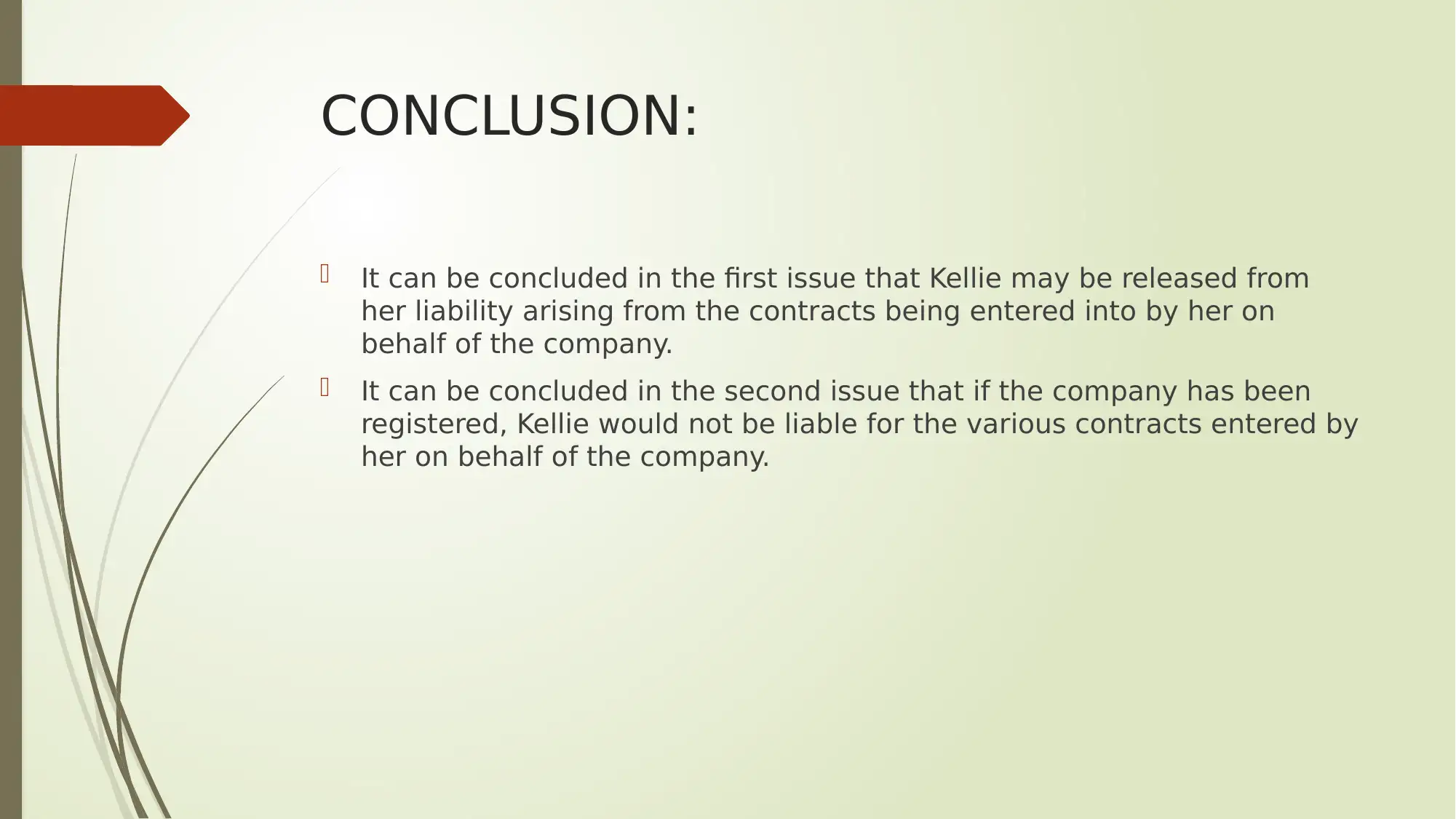
CONCLUSION:
It can be concluded in the first issue that Kellie may be released from
her liability arising from the contracts being entered into by her on
behalf of the company.
It can be concluded in the second issue that if the company has been
registered, Kellie would not be liable for the various contracts entered by
her on behalf of the company.
It can be concluded in the first issue that Kellie may be released from
her liability arising from the contracts being entered into by her on
behalf of the company.
It can be concluded in the second issue that if the company has been
registered, Kellie would not be liable for the various contracts entered by
her on behalf of the company.
⊘ This is a preview!⊘
Do you want full access?
Subscribe today to unlock all pages.

Trusted by 1+ million students worldwide
1 out of 14
Your All-in-One AI-Powered Toolkit for Academic Success.
+13062052269
info@desklib.com
Available 24*7 on WhatsApp / Email
![[object Object]](/_next/static/media/star-bottom.7253800d.svg)
Unlock your academic potential
Copyright © 2020–2025 A2Z Services. All Rights Reserved. Developed and managed by ZUCOL.


